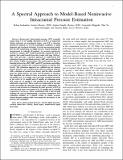| dc.contributor.author | Jaishankar, Rohan | |
| dc.contributor.author | Fanelli, Andrea | |
| dc.contributor.author | Filippidis, Aristotelis | |
| dc.contributor.author | Vu, Thai | |
| dc.contributor.author | Holsapple, James | |
| dc.contributor.author | Heldt, Thomas | |
| dc.date.accessioned | 2021-03-11T22:15:39Z | |
| dc.date.available | 2021-03-11T22:15:39Z | |
| dc.date.issued | 2020-08 | |
| dc.identifier.issn | 2168-2194 | |
| dc.identifier.issn | 2168-2208 | |
| dc.identifier.uri | https://hdl.handle.net/1721.1/130127 | |
| dc.description.abstract | Background: Intracranial pressure (ICP) normally ranges from 5 to 15 mmHg. Elevation in ICP is an important clinical indicator of neurological injury, and ICP is therefore monitored routinely in several neurological conditions to guide diagnosis and treatment decisions. Current measurement modalities for ICP monitoring are highly invasive, largely limiting the measurement to critically ill patients. An accurate noninvasive method to estimate ICP would dramatically expand the pool of patients that could benefit from this cranial vital sign. Methods: This article presents a spectral approach to model-based ICP estimation from arterial blood pressure (ABP) and cerebral blood flow velocity (CBFV) measurements. The model captures the relationship between the ABP, CBFV, and ICP waveforms and utilizes a second-order model of the cerebral vasculature to estimate ICP. Results: The estimation approach was validated on two separate clinical datasets, one recorded from thirteen pediatric patients with a total duration of around seven hours, and the other recorded from five adult patients, one hour and 48 minutes in total duration. The algorithm was shown to have an accuracy (mean error) of 0.4 mmHg and −1.5 mmHg, and a precision (standard deviation of the error) of 5.1 mmHg and 4.3 mmHg, in estimating mean ICP (range of 1.3 mmHg to 24.8 mmHg) on the pediatric and adult data, respectively. These results are comparable to previous results and within the clinically relevant range. Additionally, the accuracy and precision in estimating the pulse pressure of ICP on a beat-by-beat basis were found to be 1.3 mmHg and 2.9 mmHg respectively. Conclusion: These contributions take a step towards realizing the goal of implementing a real-time noninvasive ICP estimation modality in a clinical setting, to enable accurate clinical-decision making while overcoming the drawbacks of the invasive ICP modalities. | en_US |
| dc.description.sponsorship | National Institute of Neurological Disorders and Stroke (Grant R21-NS084264) | en_US |
| dc.publisher | Institute of Electrical and Electronics Engineers (IEEE) | en_US |
| dc.relation.isversionof | http://dx.doi.org/10.1109/jbhi.2019.2961403 | en_US |
| dc.rights | Creative Commons Attribution-Noncommercial-Share Alike | en_US |
| dc.rights.uri | http://creativecommons.org/licenses/by-nc-sa/4.0/ | en_US |
| dc.source | Prof. Heldt via Phoebe Ayers | en_US |
| dc.title | A Spectral Approach to Model-Based Noninvasive Intracranial Pressure Estimation | en_US |
| dc.type | Article | en_US |
| dc.identifier.citation | Jaishankar, Rohan et al. "A Spectral Approach to Model-Based Noninvasive Intracranial Pressure Estimation." IEEE Transactions on Information Technology in Biomedicine 24, 8 (August 2018): 2398 - 2406. | en_US |
| dc.contributor.department | Massachusetts Institute of Technology. Institute for Medical Engineering & Science | en_US |
| dc.relation.journal | IEEE Transactions on Information Technology in Biomedicine | en_US |
| dc.eprint.version | Author's final manuscript | en_US |
| dc.type.uri | http://purl.org/eprint/type/JournalArticle | en_US |
| eprint.status | http://purl.org/eprint/status/PeerReviewed | en_US |
| dspace.date.submission | 2021-03-05T18:06:07Z | |
| mit.journal.volume | 24 | en_US |
| mit.journal.issue | 8 | en_US |
| mit.license | OPEN_ACCESS_POLICY | |
| mit.metadata.status | Complete | |
